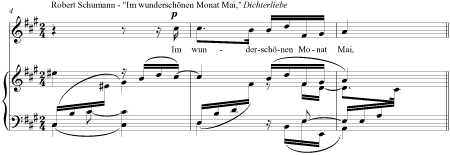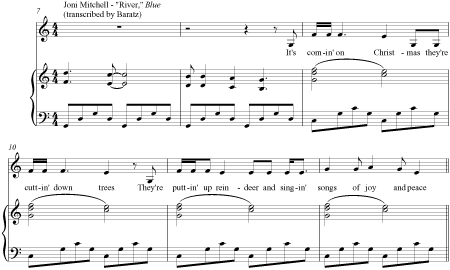Harmony in popular music is often looked at by classical connoisseurs like a simple country cousin. Occasionally it surprises with a bit of deftness, but generally it is seen as a watered-down version of common-practice tonality. These two songs at first glance seem to be coming from rather different places:


Their conceptions, though, are quite similar. Both texts clash inner anxieties with the exuberance and celebration of a new season. The tension between these two emotional territories is paralleled with a tension between major and minor modes. Where they diverge in this scheme reveals fundamental differences between the harmonic languages of the classical art song and the modern popular song.
Schumann moves from f# minor to A major with great elegance. Because the modulation doesn't alter the key signature, the transitions aren't noticed until a cadence point is reached. After the four bar introduction implies a resolution to f# minor, the next bar brings in the singer and a swift modulation to A major. The harmonic rhythm is fast throughout, with no harmony sustaining for more than a single measure.
“River,” in comparison, feels a little clunky. Rather than modulate between relative keys, it presents the two harmonies side by side. The harmonic rhythm here is significantly longer. The first half of each verse is harmonized with a C major chord that lasts for about ten seconds. It only takes a few seconds to sing the first line of “Im wunderschönen Monat Mai.”
This protracted duration gives a different kind of meaning to each harmony. Since they're given time to breathe, they're able to establish a more significant presence in musical space. They feel less subservient to a larger harmonic scheme and more like contemplative objects worthy of individual appreciation. The effect is not altogether different from a piece like Music for 18 Musicians. The drawing out of a short progression over time allows the listener to “inhabit” each harmony for a while.
The relationship between singer and accompaniment is very different in these songs. The vocal line in “River” floats on top of the accompaniment. The ideal of the art song is to entangle the two, giving them similar structural and expressive importance. Much of the expression in “River” comes from Mitchell's singing. The accompaniment in the Schumann does almost as much to shape the vocal line as the singer does. The brief harmonies color individual words, while Mitchell's harmonies color vast spaces.
This key difference evolved out of another major distinction between “art music” and popular music. While one is composer-oriented, the other is driven by performers. Though it's common for performers of popular music to play someone else's songs, they usually learn them from another's performance. Since the score is the primary document for classical music, the notes must speak for themselves more. Joni Mitchell can use simple backing for expressive vocals because her performance is the final product. Robert Schumann, tied to a less forgiving tradition, couldn't take such chances.
The resulting styles use the same triadic tonality, though in slightly different ways. Longer pop harmonies dramatize change, even as slight as I moving to vi. Classical harmony is about the ultimate destination (the similarities here between popular songs and minimalism/other “ergodic” music are striking to say the least). These two “dialects” should not be belittled either way with generalizations and value judgements, but recognized as equally valid means for tackling the same problems.
2 comments:
Adam,
Nice post. I'd just hope to make a couple brief comments.
Keeping in mind, of course, your caveat that none of what you say represents a "value judgment," it's difficult not to attach judgment to the statement that popular music is part of a more "forgiving" tradition than classical music. There seems to be a (perhaps unintentional) implication that pop music will forgive lesser talents than classical music. This might be true, but your discussion of harmonic treatment and taste doesn't really justify the implication. One might also see the same implication in your characterization of Mitchell's music as "clunky."
Secondly, I've got to take issue with the assertion that the performance is the final goal of popular music composition, and that the written score is the final goal of classical music composition. It somewhat damns both endeavors-- one, for slighting classical composers in their pursuit of a sonic art object achieved through the visually-transmitted instructions provided by sheet music, and two, for not considering that the *recording* might be the final art-object-goal in popular music. And it's certainly possible to argue that the CD is as permanent and immutable an object as a composer's written score, with audience expectations as high and unforgiving. (If pop audiences didn't put such emphasis on reproducing the CD-recorded versions of pop songs, we wouldn't have such a severe epidemic of pop stars lip-synching at their own shows.)
At any rate, it's a great analysis. Looking forward to seeing more.
Pop harmony is a direct descendant of classical harmony, to which it added the blues form. That being said, the striking difference in length of pieces between the two genres led them to develop along fairly distinct direction.
Classical music tells a story, within a unit of time on the order of 30 minutes. Pop music reenacts a climactic moment, usually shorter than 4 minutes. Both require rather different skills, both composition wise, and execution wise. The fact that a pop piece is played over and over, makes the usual classical crescendo-like structure impossible. Instead of heightened dynamics, characteristic of the classical world, pop music resorts to compression and limiters, to guarantee an equal volume throughout the entire performance. This is the exact opposite of dynamics. Being a piano composer, of both classical like and pop oriented music, I couldn't tell which one is easier! The fact that a pop piece might be written faster, doesn't amount to much, if, as expected, the piece doesn't sell.
That being said, I enjoyed your post, and I'm taking the liberty of directing you to my page on wordpress: http://t0hierry.wordpress.com/
music theory (and practice!) blogs are few and far in between. I'd be happy to welcome your comments.
thierry
Post a Comment